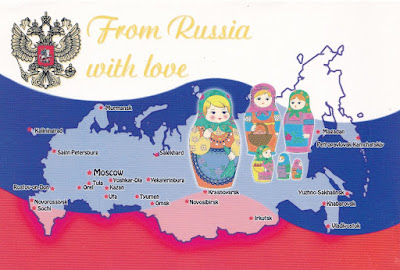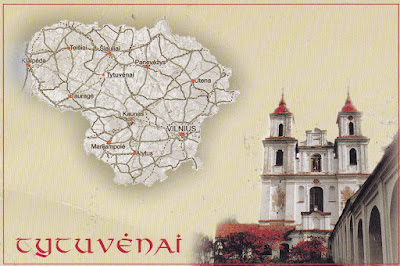Saltaire, West Yorkshire, is a complete and well-preserved industrial village of the second half of the 19th century. Its textile mills, public buildings and workers' housing are built in a harmonious style of high architectural standards and the urban plan survives intact, giving a vivid impression of Victorian philanthropic paternalism.
Friday, 27 November 2015
Vaduz, Liechtenstein
Vaduz is the capital of Liechtenstein and the seat of the national parliament. The town, located along the Rhine, has about 5,100 inhabitants.
Valencia, Spain
Valencia is the capital of the autonomous community of Valencia and the third largest city in Spain after Madrid and Barcelona.
On the postcard id the Plaza de la Virgen ( Plaça de la Mare de Deu) a square in Valencia located in center of the city. Around the square are three buildings: the Cathedral of Santa Maria , the Basilica of the Virgin of the Helpless and the Palace of the Generalitat .
Ljubljana, Slovenia
Ljubljana is Slovenia's capital and largest city. It's known for its university population and green spaces, including expansive Tivoli Park. The curving Ljubljanica River, lined in outdoor cafes, divides the city's old town from its commercial hub.
Chișinău, Moldova
Chișinău or Kishinev is the capital and largest city of the Republic of Moldova. It is Moldova's main industrial and commercial center, and is located in the middle of the country, on the river Bîc.
On the postcard is The National Museum of Fine Arts in Chișinău, founded in November 1939.
Jelgava palace, Latvia
Jelgava Palace or Mitava Palace is the largest Baroque-style palace in the Baltic states. It was built in the 18th century based on the design of Bartolomeo Rastrelli as a residence for the Dukes of Courland in their capital – Mitava, Latvia.
Russian dolls - matryoshka
A matryoshka doll, also known as a Russian nesting doll, or Russian doll, refers to a set of wooden dolls of decreasing size placed one inside another.
Lake Sebu, Philippines
Popularly known as the Seven Falls, it features series of seven waterfalls of majestic cascades lined-up one after the other.,
Sweden
Sweden is a Scandinavian nation of thousands of coastal islands, inland lakes, forests and mountains. Its principal cities, eastern capital Stockholm and southwestern Gothenburg and Malmö, are all on the sea. Stockholm is home to royal palaces, parkland and museums such as open-air Skansen. Its 13th-century old town, Gamla Stan, is set on islands joined by bridges and ferries.
Russia
Russia, the world’s largest nation, borders European and Asian countries as well as the Pacific and Arctic oceans. Its landscape ranges from tundra and forests to subtropical beaches. It’s famous for novelists Tolstoy and Dostoevsky, plus the Bolshoi and Mariinsky ballet companies. St. Petersburg, founded by legendary Russian leader Peter the Great, features the baroque Winter Palace, now housing part of the Hermitage Museum’s art collection.
Taiwan
Taiwan is a small island nation 180km east of China with contemporary cities, hot springs resorts and dramatic mountainous terrain. Taipei, the country’s capital in the north, is known for its busy night markets and street-food vendors, Chinese Imperial art at the National Palace Museum and Taipei 101, a 509m-tall, bamboo-shaped skyscraper with an observation deck.
Bahrain
Bahrain, a nation comprising more than 30 islands in the Persian Gulf, has been at the center of major trade routes since antiquity. In its modern capital, Manama, the acclaimed Bahrain National Museum showcases artifacts from the ancient Dilmun civilization that flourished in the region for millennia. The city's thriving Bab el-Bahrain souk offers wares from colorful handwoven fabrics and spices to pearls.
Cyprus
Cyprus, an island in the eastern Mediterranean, has rich, turbulent history stretching back to antiquity. Known for its beaches, it has a rugged interior with wine-growing regions. It’s separated into a Greek south and Turkish north, with the capital Nicosia also divided. Coastal Paphos is famed for its archaeological sites relating to the cult of Aphrodite, including ruins of palaces, tombs and mosaic-adorned villas.
Finland
Finland is a Northern European nation bordering Sweden and Russia. Its capital, Helsinki, sits on a peninsula and coastal islands in the Baltic Sea, and is home to the 18th-century fortress Suomenlinna, the Seurasaari open-air museum and a neoclassical cathedral. The Northern Lights can be seen from its Arctic Lapland province, also home to the country’s main ski resorts.
Poland
Poland is an eastern European country on the Baltic Sea known for its medieval architecture, Jewish heritage and hearty cuisine. In the city of Krakow, 14th-century Wawel Castle rises above the medieval Old Town, home to Cloth Hall, a Renaissance trading post in Rynek Glówny (market square). Nearby is the Auschwitz-Birkenau concentration camp memorial, and Wieliczka Salt Mine, with tunnels to explore.
Estonia
Estonia, a country in Northern Europe, faces the Baltic Sea and Gulf of Finland. Including more than 1,500 islands, its diverse terrain spans rocky beaches, old-growth forest and many lakes. Formerly part of the Soviet Union, it's dotted with castles, churches and hilltop fortresses. The capital, Tallinn, is known for its preserved Old Town, museums and the 314m-high Tallinn TV Tower’s observation deck.
Lithuania
Lithuania is a country and the southernmost of Europe’s Baltic states, a former Soviet bloc nation that borders Poland, Latvia and Belarus. Its capital, Vilnius, near the Belarus border, is known for its medieval Old Town, subsequent Gothic, Renaissance and baroque architecture, and its 18th-century cathedral. Hilltop Gediminas' Tower, a symbol of the city and the nation, offers sweeping views.
Indonesia
Indonesia, a Southeast Asian nation made up of thousands of volcanic islands, is home to hundreds of ethnic groups speaking many different languages. It’s is known for its beaches, volcanoes and jungles sheltering elephants, tigers and Komodo dragons. On the island of Java lies Indonesia's vibrant, sprawling capital, Jakarta, and the city of Yogyakarta, known for gamelan music and traditional puppetry.
Monday, 23 November 2015
Palmeral of Elche, Spain
The Palmeral of Elche, a landscape of groves of date palms, was formally laid out, with elaborate irrigation systems, at the time the Muslim city of Elche was erected, towards the end of the tenth century A.C., when much of the Iberian peninsula was Arab. The Palmeral is an oasis, a system for agrarian production in arid areas. It is also a unique example of Arab agricultural practices on the European continent. Cultivation of date palms in Elche is known at least since the Iberian times, dating around the fifth century B.C.
Renaissance Monumental Ensembles of Úbeda and Baeza, Spain
The urban morphology of the two small cities of Úbeda and Baeza in southern Spain dates back to the Moorish 9th century and to the Reconquista in the 13th century. An important development took place in the 16th century, when the cities were subject to renovation along the lines of the emerging Renaissance. This planning intervention was part of the introduction into Spain of new humanistic ideas from Italy, which went on to have a great influence on the architecture of Latin America.
Pitons, cirques and remparts of Reunion Island
The Pitons, cirques and remparts of Reunion Island site coincides with the core zone of La Réunion National Park. The property covers more than 100,000 ha or 40 % of La Réunion, an island comprising two adjoining volcanic massifs located in the south-west of the Indian Ocean. Dominated by two towering volcanic peaks, massive walls and three cliff-rimmed cirques, the property includes a great variety of rugged terrain and impressive escarpments, forested gorges and basins creating a visually striking landscape. It is the natural habitat for a wide diversity of plants, presenting a high level of endemism. There are subtropical rainforests, cloud forests and heaths creating a remarkable and visually appealing mosaic of ecosystems and landscape features.
Subscribe to:
Comments (Atom)



















































